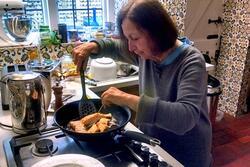The Amazing Flavors of Chef Jerzy
As Jews, some of our classic cultural touchpoints occur at the kitchen table. Experimenting with the cuisine of the global Jewish diaspora is a fun way to experience a new culture. Kosher personal chef Jerzy Gonzalez-Arroyo takes her clients on a cultural journey of amazing Sephardi flavors.
Her cooking journey began as an 8-year-old at the side of her Puerto Rican grandmother, with family recipes like papas rellenas, three-bite beef-stuffed potato balls. Always an adventurous eater, Jerzy has sampled foods from cultures all over the world and felt inspired by the challenge of recreating her favorite dishes.
“I loved copying sauces and dips!” she exclaimed in our conversation during my trip through New Jersey. “I would take a pen and paper and write down what I thought the ingredients were and then make the sauce several times until I nailed it.” Doing this demystified the magic behind food; from the gourmet classics to large chain favorites, it was all doable.
As an adult, Chef Jerzy Gonzalez-Arroyo reconnected with her Spanish-Jewish heritage after deep and careful research into her lineage. She took the bold step of getting involved with her local Conservative synagogue in Cherry Hill and found ways of bringing Puerto Rican cuisine and traditional Sephardi food into her proudly Jewish home.
Even though her family wasn’t religiously observant, so many of her childhood memories around food sound distinctly Jewish. Large, steaming pots of soup with many ingredients, cooked slowly to unravel a beautifully melded, savory elixir. The Sephardi practice of “seasoning in layers”—in which ingredients are marinated, salted or spiced before being introduced to the pot at each stage of cooking—is key to her process.
Diving headfirst into Jewish food has had its pitfalls and mishaps. Chef Jerzy sometimes uses grocery delivery phone apps to save time sourcing ingredients. “I wanted five pounds of kosher brisket, but the display had the item listed as being only one pound, so I clicked it five times. When the order finally arrives, each brisket is three pounds! I cooked it all in a few different ways so that my family could keep eating it without getting bored,” she said with a laugh.
Chef Jerzy Gonzalez-Arroyo has her cherished favorites from within traditional Sephardi cuisine. She makes jeweled rice with a Puerto Rican twist by adding toasted pumpkin seeds. A perfect dish for Rosh Hashana, she includes plump and juicy pomegranate, freshly loosened from their ruby-red clusters. Very finely grated wisps of carrot add to the sweetness and the simanim checklist.
“I use jasmine rice, which isn’t traditional in jeweled rice, but I really recommend it for home cooks trying to make this, because it keeps the dish light and fluffy instead of becoming claggy after you toss in the rest of the ingredients,” she advised. Rinsing the rice before cooking also helps.
The transition from eager home cook to professional personal chef happened almost overnight. “I got a call to cook for a well-known professional athlete and he wanted me back again and again and recommended me to even more people.” Chef Jerzy Gonzalez-Arroyo is very discreet about her discerning VIP clientele.
While personal chef services are considered a luxury, it can be worth the splurge for family holidays, milestones, and birthdays. Chef Jerzy Gonzalez-Arroyo advises prospective clients to go in-depth about what their tastes and preferences are. She even welcomes the chance to learn about what dishes and ingredients her clients don’t like. “You won’t hurt my feelings!” she said.
She’s also more than willing to tweak traditional recipes for different diets, like vegan and gluten-free. Since she keeps a kosher home, Chef Jerzy Gonzalez-Arroyo is already used to stealthily employing the use of substitutes for dairy or meat ingredients. But she won't compromise on taste. “I’m my own worst critic," she admitted. “One time, I made a Spanish dish using vegan chorizo and I didn’t really like it. I was shocked when my client thought the dish was fantastic and even wanted me to make it again!”
Rosh Hashana is a time when Jewish families gather with friends around the table for a festive meal. Chef Jerzy Gonzalez-Arroyo uses the Rosh Hashana holiday to celebrate her Spanish-Jewish culture with this amazing menu: The meal starts off with a nice kosher red wine, probably a selection that she’s been sipping on and even cooking with. Then comes a round challah, sweetened with dried fruits. The first appetizer is a colorful array of sliced apples drizzled with honey. Stuffed roasted red bell peppers are a standard Sephardi side dish. The main dish is pastelón, a hearty lasagna-style casserole made of thin layers of plantains in between layers of spiced ground beef (see recipe below). Dessert is a dense and dairy-free flourless chocolate cake, a mic drop on the evening’s delights.
May the memories you make at your holiday table awaken both your palate and your spirit this High Holy Day season. ¡Beteavon!
Pastelón (Puerto Rican Plantain Lasagna)
6 to 8 servings
Ingredients
• 5 ripe (yellow) plantains, about 4 pounds
• 1/2 cup vegetable oil
• 1 pound ground beef (preferably ground round) or ground turkey
• 2 teaspoon adobo seasoning blend
• 3 packs sazón
• 1 small white onion, minced (about 1 cup)
• 1 green bell pepper, minced (about 1 cup)
• 1 tablespoon recaito flavoring base (store-bought or homemade), or 2 tablespoons chopped cilantro
• 6 pimento-stuffed green olives, sliced
• 1 teaspoon dried oregano
• 1 cup tomato sauce
• 2 cups non-dairy cheese (Chef Jerzy uses Daiya)
• 2 large eggs
• 1/2 teaspoon baking soda
Method
Preheat the oven to 350°F:
Lightly grease a 10x10 casserole dish (for a thicker pastelón) or 9x13 casserole dish (for a thinner pastelón) with nonstick cooking spray or butter.
Cut off both ends from the plantain, then use the tip of your knife to cut a slit down the back. Using your two thumbs, remove the peel from the plantain and discard the peel.
Once you’ve peeled all the plantains, slice each one in half down the length. Separate the two halves and flip them onto their flat sides to create a stable base. Place your palm flat on top of the plantain, and use a sharp knife to slice parallel to the cutting board and cut the plantains into very thin slices (about 1/4-inch thick). Set aside.
(Alternatively, you can use a mandolin to slice the plantains thinly, but be careful because the plantains are soft and the mandolin is sharp!)
In a large skillet, heat the vegetable oil to 300°F over medium heat (check the temperature with a candy thermometer or instant-read thermometer). Line a plate with paper towels to drain the plantains after frying, and set next to the stove.
Place four or five slices of plantains into the oil and fry for about 1 1/2 minutes on each side, or until the plantains have browned slightly. Remove from the skillet to the paper-lined plate to drain. Continue frying the remaining plantains.
Drain all but 1 tablespoon of oil from the pan you used to fry the plantains. Return the pan to the stove and heat over medium-high heat. Add the ground beef and season with the adobo and sazón.
Continue to cook the meat, breaking it up into crumbles, for 6 minutes or until browned. Drain the meat by pouring it into a colander, but leave a bit of the grease in the pan to cook the vegetables. Return the empty pan to the heat and cook the onions, bell pepper, and recaito for 3 minutes or until glossy. Add the olives, capers, and dried oregano, and cook for 2 more minutes.
Return the ground beef to the pan with the vegetables, along with the tomato sauce, and then stir to combine. Bring the mixture to a simmer, then remove the pan from the heat.
Cover the bottom of the casserole dish with a single layer of the fried plantain strips. Spoon a 1-inch layer of the ground beef mixture onto the plantains. Top with 1/2 cup of shredded cheese. Repeat with another layer of plantains, meat, and cheese (reserve the remaining 1 cup of cheese). Top with a final layer of plantains.
In a small bowl, whisk together the eggs and baking soda until frothy. Pour this mixture over the plantains.
Bake the pastelón, uncovered, for 25 minutes. Remove from the oven and top with the remaining cup of cheese. Return the dish to the oven and cook for an additional five minutes, until the cheese has melted.
Remove the pastelón from the oven. Allow it to cool for at least fifteen minutes before slicing and serving, which helps it maintain its shape when sliced.
Leftovers can be stored, covered, in the refrigerator for up to three days. To reheat, cut a portion and place either in the microwave or the oven until warmed through.







